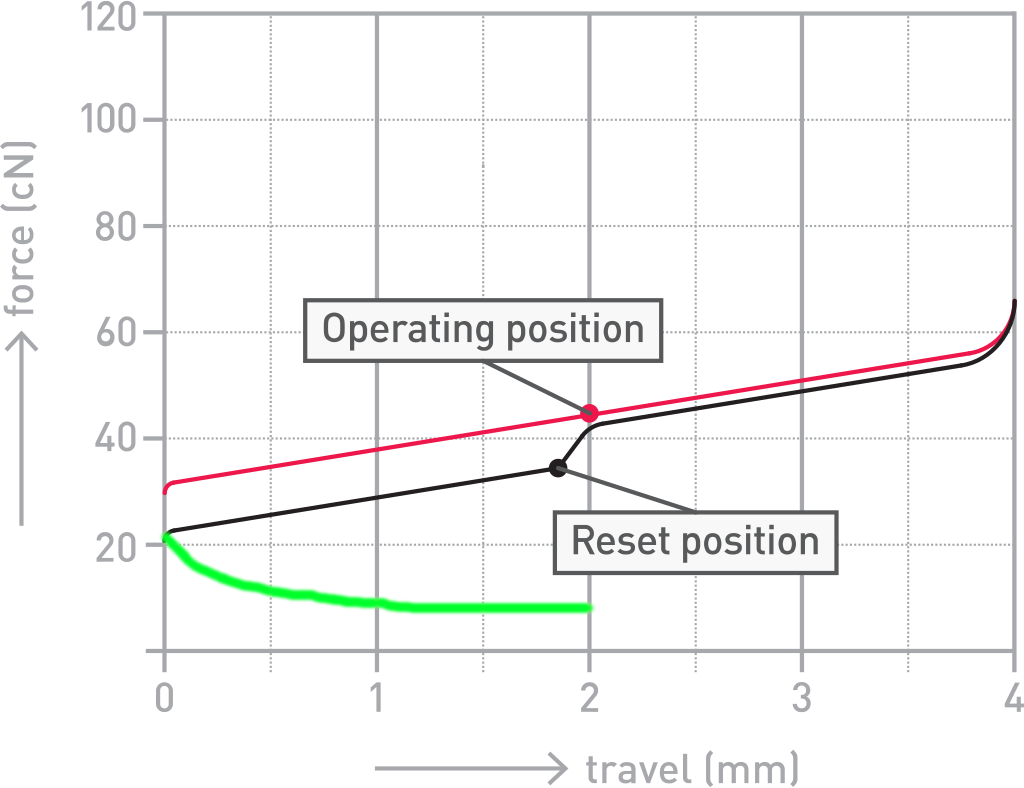Work work work work work work
Do less!
There are two components of effort in typing. The first is the motion to get to the key, and the second is the effort required to actuate the key.
You've already seen how Svalboard reduces the reach to each key by positioning the keys immediately next to the fingertips. This results in approximately a 90% reduction in movement versus traditional keyboards.
Svalboard keys offer a completely different force profile than traditional key switches, be they linear, tactile, or anything else.
What's less obvious is how the forces on Svalboard and the actual effort of pressing keys differs from traditional keyboards. Many people suffering from RSI today have moved towards ergonomic split keyboards with “light” keys.
Compared to the original ANSI spec of ~60 grams, the “light” ~40g switches available on kinesis advantage and other such devices are indeed light… historically speaking anyway. And if you have the right board you can even get 20-25g Choc switches.
But they’re still a lot of work, and they can still cause injury! We have customers who come from Ergodox keyboards with custom sprung and custom lubed 15 gram linear switches. These are people who have literally disassembled, changed springs, custom-lubed and reassembled every single switch on their own keyboards in search of comfort.
And it's hard to find switches this light with any kind of tactility because of the mechanical constraints of the switch design.
Enter the DH/lal/Svalboard mechanism — with magnets acting as the spring, the force profile is decidedly nonlinear, following an inverse-square function. And the total work is the area underneath that precipitously dropping curve:
Here’s a rough comparison of the Svalboard key profile with a typical 45g gaming key switch, the well-known Cherry MX Red — (Svalboard is roughly represented in green):
Remember that the actual effort required to press the switch is the integral of the force throughout the stroke, not just the force to actuate! It’s not just that typical switches are two or even three times heavier to actuate! It’s the AREA under the curve!
Linear switches have you pressing that 45g (or whatever) for the whole stroke until they bottom out, usually increasing slightly in force throughout. Tactile switches have some degrees of buildup and breakaway, but it’s very modest and the overall force remains quite high throughout the stroke.
Svalboard switches have no movement until the nominal 20g breakaway force, and then fall off with ~1/x^2. So the breakaway is precipitous and incredibly tactile.
No chasing
100% tactility means no chasing to the bottom of the keystroke looking for certainty, and no pounding!
And the tactility means that instead of a mushy, uncertain key that is easily mis-triggered, you can actually rest against a 20g Svalboard key comfortably. Most people can’t even rest their fingers on a 25g Choc switch without getting accidental keypresses!
So the total work for a key activation is about 90% less than a typical key switch, and still significantly less than even a custom-lubed linear 15g key switch due to the breakaway force profile.
Feel it for yourself
Nobody fully appreciates this until they feel it in action!
Because this is such an important part of the Svalboard/Datahand concept, I’ve added a “sample cluster” item to the shop — order one and I’ll send you a working mechanical example from the parts bin. The cost barely covers my time away from development work to ship, but I think it’s important outreach :)





This is so, so cool! Thank you for writing this. I can't afford a Svalboard on my nonexistent salary right now, but this was interesting to learn about, and helped me settle a debate I was having with myself about what kind of regular key switches to get, as a side effect. Keep up the stellar work~